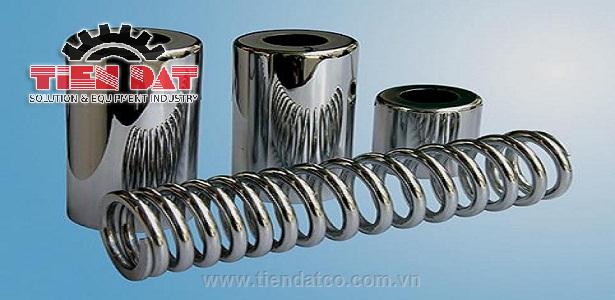News
Pretreatment of parts for Electroless nickle plating
Electroless Nickle Plating Electroless nickel plating can be a highly effective overlay solution if some pre-treatment measures are adequate. By eliminating grease, oil, imperfections and other contaminants before the nickel plating process, there will be less chance of the metal coating of the substrate cooling tower with a non-uniform uneven layer, inefficient and too cumbersome, nickel phosphorus.

Electroless nickel plating, also known as autocatalytic plating or EN, is a process of producing a nickel-phosphorus alloy layer on a substrate, usually plastic or metal like copper, which works to enhance and wipe the material. This technique is a complete substitute for electroplating chemicals, and its benefits include:
• Zero, requires electrical power
• Even overlays irrespective of wallpaper
• Particularly plated volume and thickness of capacity
• Diverse finish (dim, bright, semi bright)
• No complex filtering required
General Process Electroless Nickel Plating Process
As mentioned, the pre-treatment process is a necessary step in electroless nickel plating. The purpose of pretreatment to remove pollutants is not necessary which can interfere with the linkage process and lead to poor quality or unused results. Depending on the substrate used, this can be a time-consuming process that requires a few steps.
In general, the pretreatment process requires the surfaces to be cleaned with a variety of bases or chemical acids. In the middle of every chemical treatment, substrates should be washed with water to remove enough residual chemical adhesives. Grease removal can remove oil contaminants and further acid cleaning can eliminate scaling.
Consideration before additional treatment may be necessary for difficult substrates. This usually involves the use of mechanical finishing techniques to improve the surface condition of the product to be plated. The usual mechanical treatment process will cause the cleaning chemicals of a substrate including:
• Blasting
• Perfect Tumble
• Deburring
• Shot-peening
Prentice General Tips For Electroless Nickel Plating
In addition to the pollutants, one of the main factors that can reduce the efficiency of nickel-plated electroless process is overloaded localization. This potentially dangerous element emphasizes the need for rough handling of stress relief when working with steel hardening components. This is especially true when substrates have been subjected to manufacturing processes such as welding, forming and machining, which are often fatal. In order to overcome potential geochemical stress, it may be helpful to use the mechanical finishing techniques mentioned earlier.
Many factors influence the successful deposition of nickel on the substrate surface. It is important to consider the metal or plastics that are plated, tensile and final use of the product before committing to a particular surface, since each metal alloy or unique material requires Ask for specific pre-treatment time and heat guidelines.
Aluminum alloy
Aluminum alloy is a common substrate for electroless nickel plating, but each single forging or casting alloy presents unique pretreatment problems. In general, the use of alkaline zincates is often a good way to remove contaminants from aluminum alloys. An application of this chemical is usually sufficient for casting alloys, when the forged alloys may require two applications. In rare cases where zincate alkali attacks alloys (such as Type 413), it is preferable to use an acid-zinc-impregnated technique.
Depending on the requirements of the project, an electroless nickel strike may be required to achieve full nickel plating. Sources should conduct strikes at relatively low temperatures (100-120 degrees Fahrenheit) to provide optimal deposition.
Zinc Die Castings
For die casting zing, as with all die casting metal, the efficiency of electroless nickel plating is often affected by the level of quality castings, making it important to take measures that mold the same flickering and smearing. airbags. It is usually still important for the pretreatment of the surface of the molded zinc mold, so that the molding should be reduced or blown.
Once the surface finish is complete, you can use the chemicals as a phosphoric acid on a clean basis to remove further contaminants. Later, a nickel-to-zinc loan provided additional protection for zinc from possible harmful effects during plating.
Magnesium
The Magnesium sponge presents the only problem that can easily lead to corrosion during electroless nickel plating. Improper handling often can result in a black burn site in one or more of the metal pores, often affecting the use of the final product.
To avoid undesirable results, a copper cyanide strike was found to be a very beneficial pre-treatment of magnesium. Some experts also recommend that you clean up a pretreatment zincate followed by a nickel alkaline electroless citrate strike.
Beryllium
Due to the high cost and toxicity associated with beryllium, the metals provide limited plating applications. However, the low thermal expansion of the substrate does not make it ideal in some cases. Beryllium treatment generally includes a slightly alkaline soaking, a nitric acid immersion and zinc acid emulsion.
Post-Treatment parts for Electroless nickel plating
In many cases, after treatment of the end product is just as important as the pre-treatment process. Dyeing is a major concern of this coating process, and can be tackled by washing the products in pure water and / or ending with an antioxidant or anti-dandruff agent. Chromate after treatment or application of trisodium phosphate can achieve this.
Hydrogen embrittlement is a post-treatment concern. Post baking is often required to remove excessive accumulation of hydrogen in the product. Baking can also improve the long-term adhesion of nickel plating. Stress reduction deposits and blisters avoid other possible benefits of baking after treatment.
Other substrates used in Electroless Nickel Plating
There are a number of other materials that respond to electroless nickel plating. Many provide simpler pre-treatment processes in relation to the difficult substrates listed above. The following also meet electroless nickel plating:
• Leaded steel
• Resulfurized steel
• Stainless Steel
• Iron and Steel
• Copper
• Brass
• Bronze
• Beryllium
• Titanium
• Ceramics
• Plastic
